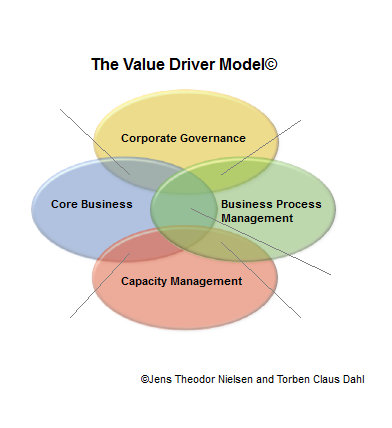In this section we will use the Value Driver Model© as a reference and demonstrate how the approach can help us to be a little more
confident on the design and role of BPM in a company.
We have already under the introduction to the Value Driver Model©, argued that
all perspectives on BPM can be identified through a closer look at the Business Sphere “Business Process Management”. Thus, an established
BPM function will contribute to optimal value creation if it applies a clear focus on its role within the identified Value Driver
Fields.
The Value Driver Model© tells us, that If BPM is ignored as an element in governing the business, neither the fields “Value Management”
nor “Balancing” exist. Management of particular business areas can, of course, set a strategic value agenda, which is also why The
Value Driver Model© presents “Line Management” as a Value Driver Field in its own right. Nevertheless, without cross-functional BPM
to ensure that the organisation is balanced, the real implementation of the full value agenda at all organizational levels top-to-bottom
will rely solely on functional line management and the cross-functional message will most likely be only confusing and short-lived.
Thus,
the “playing field” for a BPM function consists of the Value Driver Fields “Value Management”, “Balancing” and “Configuration”. In
addition, where these fields link up with the other two Value Driver Fields “Line Management” and “Optimization” two special” triple-intersections”
stand out, one is strategic and one is operational. These naturally also need careful attention, and altogether the BPM function should
apply these five headlines as hooks for the planning.
Offer yourself the opportunity to consult the Value Driver Model© before embarking
on a new BPM initiative and accept that all five value-driver fields must be addressed in your BPM programme plan. Eventually, when
a BPM governance structure is established the very same value driver fields provide the focus for monitoring and evaluation.








